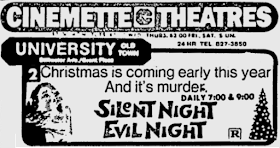I feel it is an appropriate time to geek out about one of my favorite movies ever, "Black Christmas", a Canadian flick made by Bob Clark ("Deathdream", "Children Shouldn't Play With Dead Things", "Porky's", "A Christmas Story"). Although "Black Christmas" isn't the first slasher film, it features a few tropes that later became crucial to the slasher genre that didn't get kick started until "Halloween" inspired "Friday the 13th", leading to an explosion of films about slashers racking up body counts in unsuspecting environments. The camera often serves as a first-person viewpoint of the killer; the opening scene of the film shows him prowling around in the dark outside the sorority house, peering into the windows at the people inside, all while heavy breathing is heard on the soundtrack. I can't watch the opening of Brian DePalma's "Blow Out" without thinking about how he seems to be channeling this movie. It also has an impressive body count for its era, with the insane killer making five on-screen corpses and several more implied.
But even though there are on-screen murders (the suffocation of one sorority sister with a handful of dry cleaning bags is one of the creepiest), this movie is more memorable because of its restraint, focusing on quiet passages of suspense followed by short bursts of loud screaming and violence. Much of the shock is communicated via the film's eerie sound design, as well as the dark, foreboding house where it takes place. It could just be camera angles and set decoration, but there seems to be danger everywhere.
"Black Christmas" is also a little bit smarter than many similar movies, challenging the viewer and utilizing more subtle visual storytelling devices instead of plot exposition to drive the scenes. For instance, it remains cagey about the identity and motivations of its murderer. There's no character in the movie that knows who he is, or what his back story is, and nothing is ever discovered, but through the disturbingly sexual phone calls he makes throughout the movie, you can start to pick up that at some point this psychotic man possibly murdered his baby sister Agnes after sexually assaulting her. The movie never spells it out for us, just scatters the bits of information throughout the film and leaves it up to us to piece together. Even more disturbing is how the killer's psychology ties in to his victims; he targets a group of young women and calls several of them "Agnes" before murdering them, seemingly suggesting that he views all females as "Agnes". Even worse, he seems to fixate on the fact that one of the sisters is pregnant, bringing in the "baby" aspect of his madness.
A few shots in the film remind me of Dario Argento, like a murder involving the use of a glass unicorn as a deadly weapon. Clark also uses several moments in the film where a change in focus reveals important information, like a chilling scene that shows the corpse of one of the victims staring blindly out the attic window while her father walks through the snow below outside, only just beginning to feel a sense of panic over the fact that nobody can locate her. Another focus pull later in the film reveals a second victim hanging by a hook in the attic.
The film may have no real connection to "Halloween", but you can find a number of visual cues in "Halloween" that seem to have been lifted directly from this one, such as the use of the camera's first-person perspective to represent that of the killer's. John Carpenter also seems to have noticed this movie's habit of using ominous foreground cues and background cues, often with the killer lurking somewhere in the frame of the camera, unseen by the potential victims.
As a final girl, she doesn't get to do a whole lot; "Black Christmas" only gives her one scene where she faces the killer, and after he chases her down into the basement of the house, that's pretty much it for their on-screen battle. That's a little disappointing when you view it in terms of the countless slasher movies that came afterwards, when the Laurie Strodes and Ginny Fields of the genre showed audiences how it's done.
Some viewers are frustrated by the film's ending, which offers no explanation about the killer whatsoever, even refusing to suggest his identity. Maybe that's why I love "Black Christmas" most of all, it knows that the identity of the psycho is more frightening because it's unknown and irrelevant. "Black Christmas" understands that violence and murder can be terrifyingly random, and these particular victims just happened to catch the attention of a maniac. They were simply in the wrong place at the wrong time.














No comments:
Post a Comment